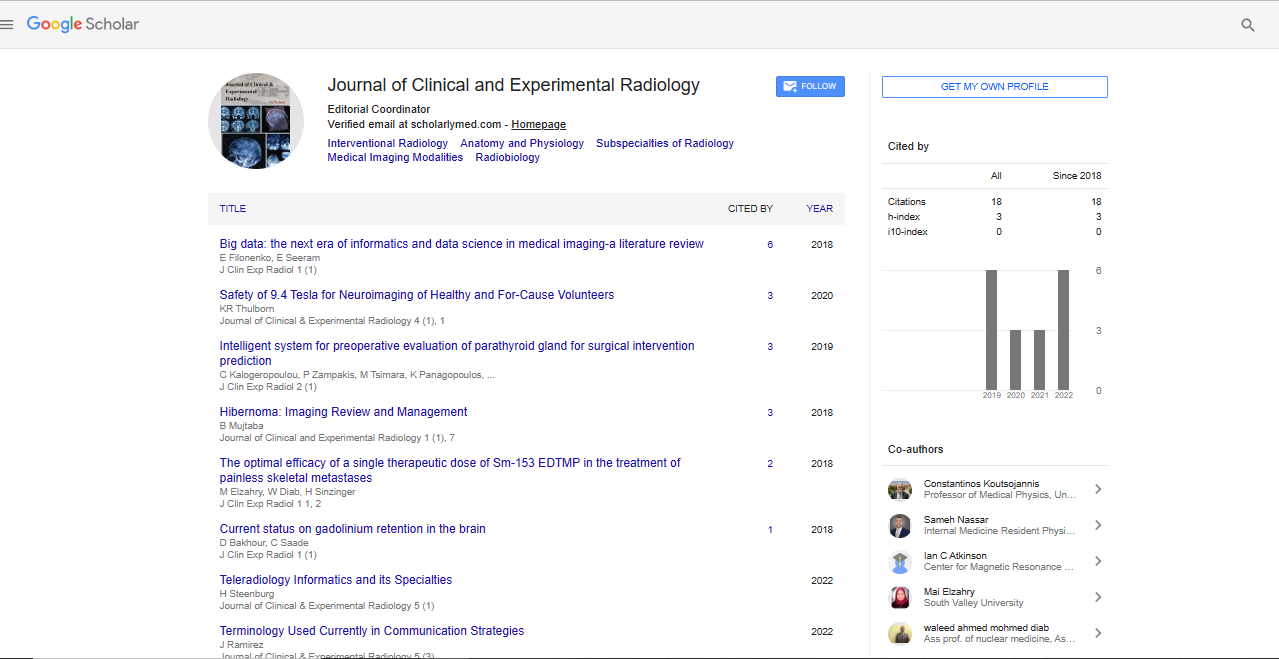Opinion Article, J Clin Exp Radiol Vol: 6 Issue: 1
Understanding Nuclear Medicine Imaging: Techniques and Applications
Sandor Burak*
1Department of Radiology, Oulu University Hospital, Oulu, Finland
*Corresponding Author: Sandor Burak
Department of Radiology, Oulu University
Hospital, Oulu, Finland
E-mail: buraksandor@gmail.com
Received date: 20 February, 2023, Manuscript No. JCER-23-93122;
Editor assigned date: 22 February, 2023, PreQC No. JCER-23-93122 (PQ);
Reviewed date: 08 March, 2023, QC No. JCER-23-93122;
Revised date: 15 March, 2023, Manuscript No. JCER-23-93122 (R);
Published date: 22 March, 2023, DOI: 10.4172/jcer.1000125
Citation: Burak S (2023) Understanding Nuclear Medicine Imaging: Techniques and Applications. J Clin Exp Radiol 6:1.
Description
Nuclear medicine imaging is a unique branch of medical imaging that uses small amounts of radioactive material to diagnose and treat various medical conditions. This technique involves the injection of a radiopharmaceutical into the patient's body, which then emits gamma rays that are detected by a special camera to produce images of the targeted organs or tissues. Nuclear medicine imaging has become an indispensable tool in diagnosing and treating many diseases, including cancer, heart disease, and neurological disorders.
Types of Nuclear Medicine Imaging
There are several types of nuclear medicine imaging procedures. Some of the most commonly used methods include:
• Single Photon Emission Computed Tomography (SPECT)
• Positron Emission Tomography (PET)
• Planar Imaging
• Scintigraphy
Each of these imaging techniques uses different radiopharmaceuticals and cameras to produce different types of images. For example, PET is used to produce images of metabolic activity in the body, while SPECT is used to create 3D images of specific organs or tissues.
Advantages of Nuclear Medicine Imaging: Nuclear medicine imaging has several advantages over other imaging techniques. Some of the benefits include
• It provides detailed information about the function of organs and tissues in the body, which can be difficult to obtain with other imaging methods.
• It can detect diseases at an earlier stage than other imaging techniques, which can lead to earlier treatment and better outcomes.
• It can provide information about the effectiveness of treatment, allowing doctors to adjust treatment plans as needed.
• It uses very small amounts of radioactive material, which minimizes the patient's exposure to radiation.
Potential Risks of Nuclear Medicine Imaging: While nuclear medicine imaging is generally safe, there are some potential risks associated with this technique. Some of the risks include:
• Allergic reactions to the radiopharmaceuticals used in the procedure.
• Exposure to radiation, which can increase the risk of cancer or other radiation-related illnesses.
• The possibility of false-positive or false-negative results, which can lead to unnecessary treatment or delayed diagnosis.
Patient Preparation for Nuclear Medicine Imaging
Before undergoing a nuclear medicine imaging procedure, patients will need to follow specific instructions to ensure the accuracy of the results. Some of the preparation steps may include:
• Fasting or following a special diet before the procedure.
• Avoiding certain medications that may interfere with the results.
• Removing any metal objects, such as jewelry or clothing with metal fasteners, from the body.
• Informing the doctor if they are pregnant or breastfeeding.
Nuclear medicine imaging is a powerful diagnostic tool that provides detailed information about the function of organs and tissues in the body. This technique has revolutionized the diagnosis and treatment of many diseases and has become an indispensable tool in modern medicine. While there are some potential risks associated with nuclear medicine imaging, these risks are generally minimal and can be managed with proper patient preparation and safety measures. With continued research and development, nuclear medicine imaging will likely continue to play a vital role in the diagnosis and treatment of many medical conditions in the future.
 Spanish
Spanish  Chinese
Chinese  Russian
Russian  German
German  French
French  Japanese
Japanese  Portuguese
Portuguese  Hindi
Hindi 